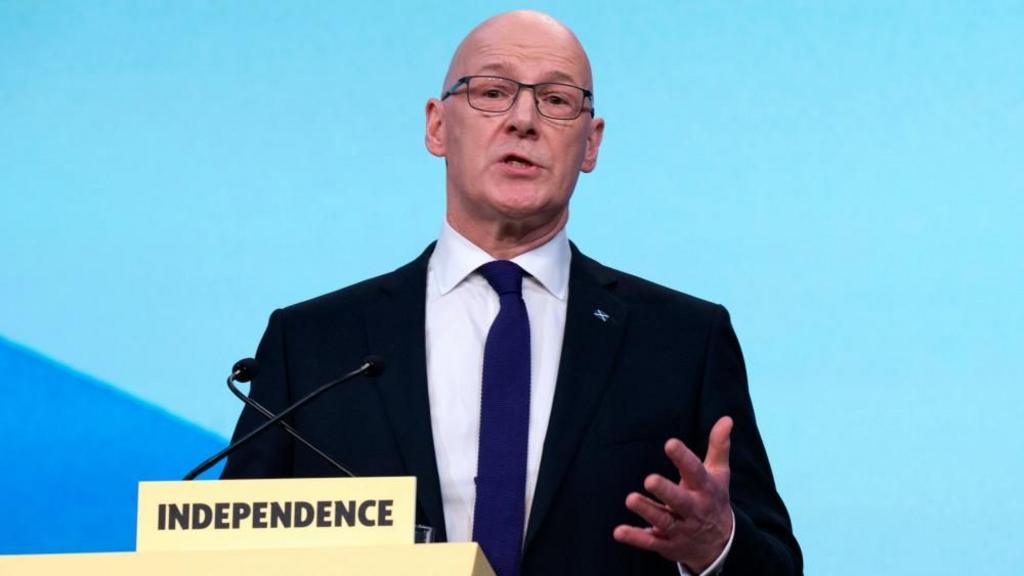“`html
Just a year or so ago, the Scottish National Party appeared to be facing significant challenges.
The party suffered substantial losses in the recent general election, with their representation in Parliament declining sharply from 48 to only nine seats.
Compounding matters, the SNP experienced a period of leadership instability, with three different leaders – Nicola Sturgeon, Humza Yousaf, and subsequently, John Swinney – taking the helm within a relatively short span of just over a year.
This rapid turnover surpassed even the leadership challenges faced by the Conservative Party in recent times.
Furthermore, a high-profile and protracted police investigation into the SNP’s financial dealings, involving Ms. Sturgeon, had been ongoing. Earlier this year, it was announced that she would not face any charges.
The party also grappled with contentious internal divisions over gender identity issues.
Moreover, the SNP has held power in the Scottish devolved government since May 2007, a tenure stretching back to before the advent of the iPhone.
Given these factors, it appeared that the weight of incumbency was catching up with the SNP, particularly with crucial elections to the Scottish Parliament looming the following May.
However, in a further demonstration of the competitiveness and unpredictability of contemporary domestic politics, the SNP’s recent trajectory provides a compelling case study.
Mr. Swinney has successfully restored stability to a party that had been experiencing considerable turbulence.
Additionally, support among rival parties, including Labour and Reform, has become fragmented.
According to analysis by More in Common:
“Since last year’s general election, Labour’s support has more than halved in Scotland while the SNP has marginally improved its standing. While not seeing as significant a rise as in England, Reform has emerged as the potential second-place party after the SNP in Scotland, suppressing the Conservatives’ vote share as well as eating into Labour’s.”
Their analysis continues:
“Despite losing 11 points in the constituency vote, this result would put the SNP just shy of a majority in Holyrood, mostly due to fragmentation in the other parties.”
It is important to note that this is a snapshot in time, not a definitive forecast. Nevertheless, it offers a fascinating insight into the current political landscape.
The prevailing sentiment among SNP party members and senior figures at the recent conference was optimistic and buoyant.
The party believes it has regained a competitive edge and is not only hopeful of securing victory in the upcoming elections but is even discussing the possibility of achieving an outright majority.
Even securing a win without a majority would represent an exceptional achievement.
Such a result would usher the party into its third consecutive decade in power within the devolved government.
Achieving a majority, however, remains a significant challenge, given the electoral system in place.
Nevertheless, it is a crucial objective for the SNP, as their renewed push for another independence referendum hinges on securing such a majority.
The party’s reasoning is as follows: their previous success in persuading the UK government to grant a referendum was predicated on having secured a majority in Holyrood a few years prior.
That majority was achieved by Alex Salmond in 2011, leading to the referendum in 2014.
Therefore, according to the current First Minister, replicating that majority is essential to invoking the precedent established over a decade ago.
The main obstacle remains the UK government’s firm opposition to another referendum, a stance reiterated in its manifesto.
Privately, senior SNP figures are considering the possibility that a majority win for them, coupled with Labour’s potential loss of power in the Welsh Senedd and poor performance in English local elections, could lead to Sir Keir Starmer’s departure from Downing Street.
However, there are many variables at play, and the future remains uncertain.
Even if Sir Keir were to leave office, the manifesto commitment against another referendum would still stand as a point of reference for the Labour Party.
The SNP would then likely raise the question of the true voluntariness of the United Kingdom’s union, given the absence of an achievable mechanism for holding another referendum.
Critics of the SNP point to what they perceive as a lackluster domestic record, citing concerns about the NHS, housing, and the high rates of drug-related deaths.
The party, however, counters with its own narrative of achievements, prominently displayed at the conference center.
These include free university tuition and free prescriptions.
Underlying these political dynamics is a fundamental reality.
The Scottish population remains nearly evenly divided on the question of independence.
This deep division provides the SNP with a substantial base of potential support.
It allows the party to continue defying the conventional wisdom that prolonged incumbency inevitably leads to electoral defeat.
The future remains to be seen.
In local, national, and UK-wide politics, established norms are being challenged in various ways.
It is also important to recognize, as both the SNP and its rivals are aware, that political fortunes can shift rapidly.
Experienced shipbuilder Duncan Anderson will take on the role on an interim basis.
The announcement came during the first minister’s keynote speech at the SNP conference in Aberdeen.
A review of the front page stories from the daily newspapers in Scotland.
The rotors, first used in 1925 on a journey to Scotland, are being revived to help emissions in shipping.
STV wants to stop producing a separate news service from Aberdeen for the former Grampian TV region.
“`

